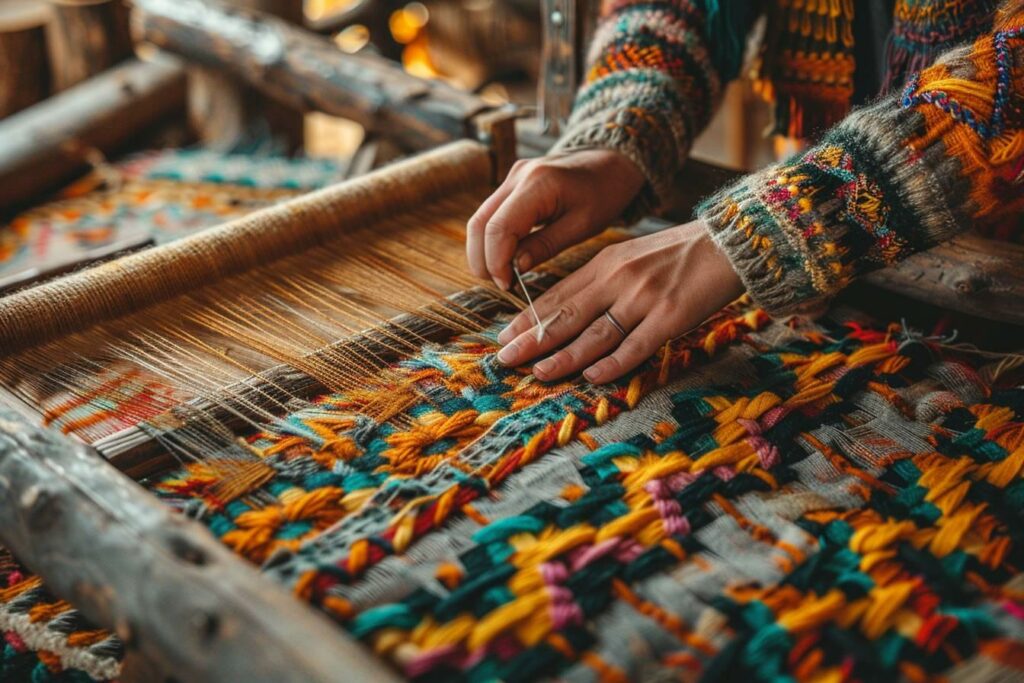Creating a rug yourself is a rewarding craft activity that lets you express your creativity while personalizing your interior. This do-it-yourself textile project offers the opportunity to design a unique decorative element, perfectly suited to your tastes and space. Whether you’re a novice or a seasoned DIY enthusiast, making a homemade rug is accessible to everyone, given the right tools and a little patience. Let’s discover together the key steps to making your own rug and bringing a touch of originality to your home.
Choosing the technique and materials for your handmade rug
Before you start making your own rug, it’s essential to select the method that suits you best. There are several rug-making techniques available to you, each with its own particularities:
- Tufted rugs
- Knotted rugs
- Woven rugs
- Hooked rugs
- The felted wool rug
The choice of materials is just as important. Opt for natural fibers like wool, cotton or jute for an authentic, long-lasting finish. For a more eco-friendly rug, consider recycling used fabrics or T-shirts. Here’s a comparative table of commonly used materials:
| Material | Advantages | Disadvantages |
|---|---|---|
| Wool | Soft, insulating, durable | High cost, delicate care |
| Cotton | Affordable, easy to work with | Less resistant than wool |
| Jute | Ecological, rustic texture | Can be rough to the touch |
| Recycled T-shirts | Economical, ecological | Less professional look |
Once you’ve chosen your technique and materials, gather the tools you’ll need to make your rug. These may include a loom, needles, scissors, tufting gun or hook, depending on the method you’ve chosen. Don’t forget to bring along a sturdy backing such as burlap or canvas to serve as a base for your creation.
Steps to making a handmade rug
There are several stages in the making of a homemade rug, whatever the technique you choose. Here’s a general guide to help you structure your project:
- Designing the motif: Draw your design on paper, or use graphic design software. This stage is crucial for visualizing the final result and planning color usage.
- Preparing the support: Attach your base canvas to a frame or loom. Make sure it is well stretched to facilitate the work.
- Making the rug: Start knotting, tufting, weaving or hooking, depending on the technique you’ve chosen. Work methodically, following your pattern.
- Finishing: Once the body of the rug is complete, trim excess yarns and even out the surface for an even finish.
- Fixing and reinforcement: Apply a layer of textile glue to the back of the rug to fix any knots or stitches. If necessary, add a non-slip backing.
Patience and precision are your best allies during this process. Don’t hesitate to take regular breaks to rest your eyes and hands. Carpets can take several days or even weeks to complete, depending on their size and complexity.

Tips for personalizing and maintaining your creation
Personalizing your handmade rug is an opportunity to express your creativity to the full. Here are a few ideas to make your project unique:
- Incorporate geometric patterns or abstract shapes for a contemporary look.
- Take inspiration from Renaissance tapestries or oriental kilims for a more traditional look.
- Incorporate three-dimensional elements such as tassels or bangs.
- Use natural dyes or vegetable dyes for an eco-responsible approach.
Caring for your handmade rug is essential to preserving its beauty and durability. Here are a few tips for caring for your creation:
- Vacuum regularly to remove dust and debris.
- In the event of a stain, clean immediately with a damp cloth and mild soap.
- Avoid prolonged exposure to direct sunlight, which can discolor the fibers.
- Rotate your carpet periodically to distribute wear.
- For a thorough cleaning, entrust your carpet to a professional.
Remember that every handmade rug tells a unique story. Small imperfections bear witness to its handmade character and add to its charm. Over time, your creation will become not only a decorative element, but also an object charged with memories and emotions.
Inspiration and resources to develop your skills
To perfect your rug-making skills, draw inspiration from a variety of sources. Textile art museums, such as the Musée des Arts Décoratifs in Paris, offer interesting insights into traditional history and techniques. Social networks, including Instagram and Pinterest, are full of creative ideas and tutorials shared by artisans around the world.
Don’t hesitate to learn from the experts. Numerous workshops and online courses are available to deepen your knowledge. Renowned artisans such as contemporary rug specialist Christophe Koziel and textile art pioneer Sheila Hicks can be inexhaustible sources of inspiration.
Joining a community of enthusiasts can also stimulate your creativity. Specialized forums and Facebook groups dedicated to textile crafts are excellent places to exchange tips, share your creations and get invaluable advice. Some websites, like Etsy, even let you sell your creations, potentially turning your passion into a lucrative business.
When you start making handmade rugs, you’re perpetuating an age-old tradition while adding your own personal touch. Each piece you create will reflect your creativity and expertise, bringing warmth and character to your home. So arm yourself with patience, let your imagination run wild, and start weaving your own textile masterpiece today.

